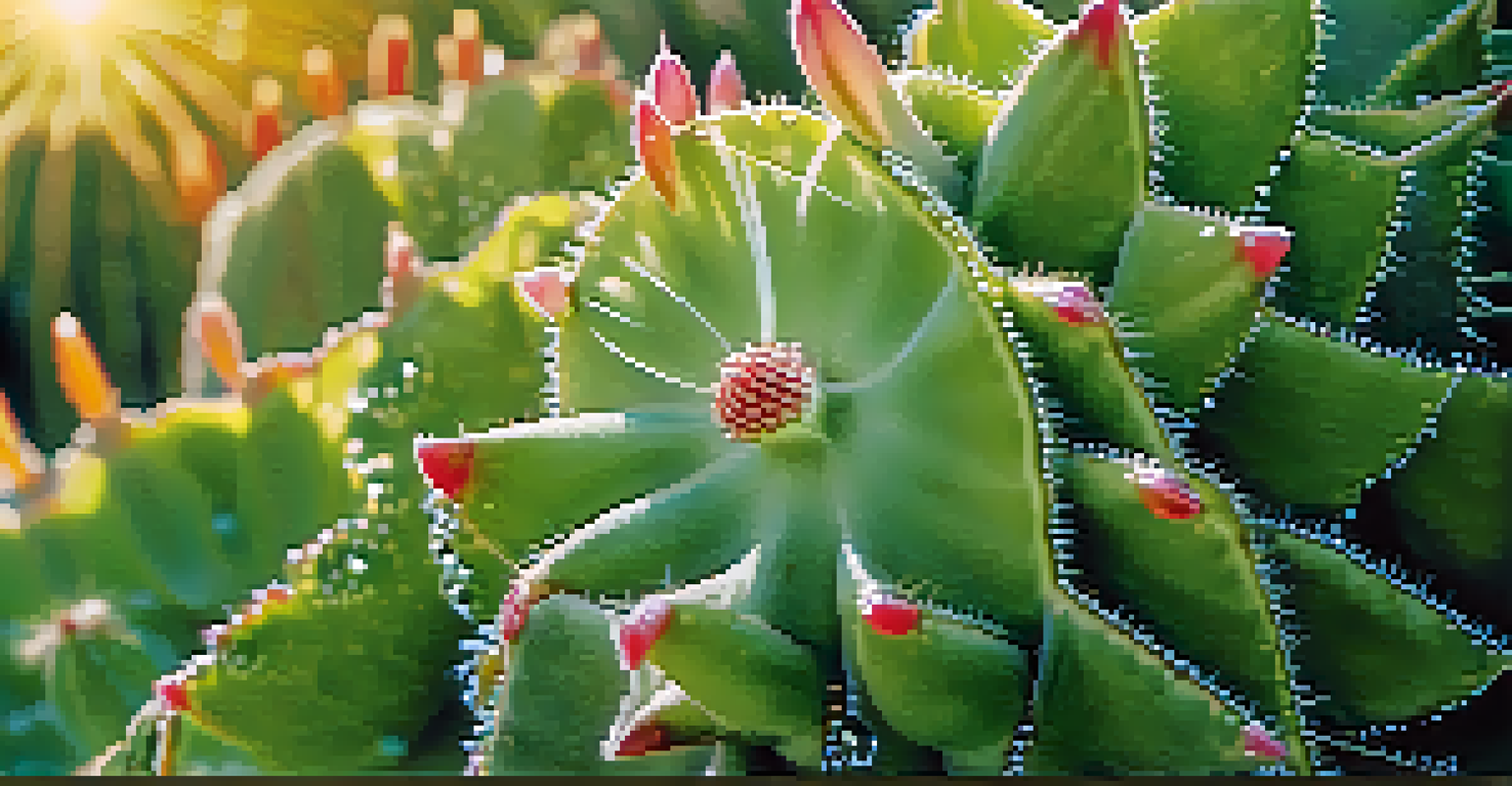Peyote Use in Shamanic Practices Related to the Afterlife

Understanding Peyote and Its Historical Significance
Peyote, a small cactus native to Mexico and the southwestern United States, has been utilized for centuries in various spiritual practices. Its psychoactive properties, primarily due to mescaline, have made it a key element in shamanic rituals. Indigenous cultures view peyote as a sacred medicine that facilitates communication with the spirit world, particularly in contexts relating to the afterlife.
Psychedelics can help us confront our fears and gain insights into our existence.
Historically, peyote use can be traced back to ancient Mesoamerican civilizations, where it played a crucial role in religious ceremonies. Shamans would consume the cactus to enter altered states of consciousness, allowing them to connect with ancestors and spiritual guides. This connection is often sought during rites of passage, healings, and, notably, when contemplating life after death.
As a bridge between the physical and spiritual realms, peyote serves as a tool for introspection and insight. The experiences it induces can provide clarity and understanding about one's existence and what lies beyond, making it a vital component of shamanic practices focused on the afterlife.
Peyote Rituals and Their Connection to the Afterlife
In shamanic traditions, rituals involving peyote are often deeply symbolic and structured to guide participants through spiritual journeys. These rituals typically begin with a sacred setting, often accompanied by songs, drumming, and other elements designed to create a conducive atmosphere for reflection. The intention is to connect with the spirit world and seek guidance regarding life and death.

During these ceremonies, participants consume peyote, which can lead to profound visions and experiences. Many report feeling a strong sense of connection to deceased loved ones, receiving messages, or gaining insights into their own mortality. This connection can provide comfort and clarity, helping individuals process grief and understand their place in the cycle of life.
Peyote's Spiritual Significance
Peyote is revered in Indigenous cultures as a sacred medicine that facilitates spiritual communication and introspection.
The peyote experience is often described as a journey through various realms, allowing individuals to confront their fears and embrace their spirituality. This transformative process is not just about seeking answers but also about personal growth and acceptance of the inevitability of death.
The Role of the Shaman in Peyote Ceremonies
Shamans play a crucial role in guiding participants through peyote ceremonies, acting as intermediaries between the physical and spiritual worlds. Their knowledge and experience are essential in creating a safe and supportive environment for participants. A skilled shaman can help individuals navigate their experiences, ensuring they derive meaning and understanding from their journeys.
The use of peyote is a sacred and integral aspect of our cultural heritage.
The shaman's responsibilities include preparing the peyote, leading prayers, and facilitating discussions about the insights gained during the ceremony. They often share their own experiences and wisdom, which helps participants feel more comfortable and open to the process. This guidance is especially important when dealing with themes of loss and the afterlife.
By establishing a trusting relationship, shamans empower individuals to confront their fears and uncertainties about death. This support is vital, as it allows participants to explore their inner worlds with confidence, ultimately enriching their spiritual understanding and acceptance of life’s transience.
Cultural Perspectives on Death and the Afterlife
Different cultures have varying beliefs about death and what follows, and peyote use reflects these diverse perspectives. In many Indigenous cultures, death is seen as a transition rather than an end, with the spirit continuing its journey in another realm. Peyote rituals often emphasize this continuity, helping individuals understand their interconnectedness with the universe.
For instance, in some traditions, the afterlife is viewed as a place where ancestors reside, and connecting with them through peyote can provide comfort. Participants may seek guidance from these spirits, hoping to learn more about their own lives and destinies. This belief fosters a sense of belonging and continuity across generations.
Shamans' Role in Ceremonies
Shamans guide peyote rituals, providing support and insight as participants navigate their spiritual journeys and confront themes of mortality.
By integrating peyote into their practices, these cultures create a rich tapestry of beliefs that honor the cycles of life and death. This perspective enables participants to view their experiences with peyote not just as personal journeys, but as part of a larger narrative that transcends individual existence.
Scientific Perspectives on Peyote and Its Effects
While the spiritual aspects of peyote are often emphasized in shamanic practices, scientific research is also exploring its effects on the human brain and consciousness. Studies have shown that mescaline, the active compound in peyote, can lead to profound alterations in perception, mood, and cognition. These changes may contribute to the feelings of interconnectedness and spiritual insight reported by users.
Research indicates that substances like mescaline can help individuals confront existential issues, including fear of death. This therapeutic potential is gaining recognition, as more people seek alternative methods for addressing mental health concerns, including anxiety and depression related to mortality. In this context, peyote can be seen as a tool for healing and personal growth.
However, it is essential to approach the use of peyote with respect and understanding of its cultural significance. Scientific exploration should complement traditional practices, ensuring that Indigenous knowledge and beliefs are honored and preserved.
Ethical Considerations in Peyote Use
As interest in peyote grows, so do the discussions around its ethical use, particularly in non-Indigenous contexts. Many Indigenous communities view peyote as sacred and integral to their cultural heritage. Consequently, it is crucial for those outside these traditions to approach peyote with respect, seeking permission and guidance when appropriate.
Cultural appropriation is a significant concern, as using peyote without understanding its cultural roots can diminish its meaning and significance. Engaging with Indigenous communities, learning about their practices, and supporting their rights to use peyote are essential steps for anyone interested in this spiritual journey. This respect fosters a more authentic connection to the experiences and insights that peyote can provide.
Ethical Use of Peyote
Respecting Indigenous cultures and practices is crucial for those seeking to engage with peyote, emphasizing the importance of cultural understanding.
Additionally, as more people seek psychedelic experiences for personal growth, it’s vital to prioritize safety and mental health. Creating spaces for informed, respectful discussions around peyote use can help balance the spiritual, cultural, and scientific perspectives, ensuring that its benefits are accessible while honoring its origins.
The Future of Peyote in Spiritual Practices
As the conversation surrounding psychedelics and spirituality continues to evolve, the future of peyote in shamanic practices remains a topic of interest. Increasingly, people are recognizing the value of traditional knowledge and the importance of preserving Indigenous practices. This recognition may lead to a resurgence of interest in peyote ceremonies, ensuring that their cultural significance is not lost.
Moreover, ongoing research into the therapeutic benefits of peyote may open new avenues for its use in mental health treatment. As society becomes more open to exploring alternative healing methods, peyote could play a pivotal role in helping individuals navigate their relationship with mortality and the afterlife.

However, this future must be approached with a commitment to ethical practices and respect for Indigenous cultures. By fostering dialogue and collaboration, we can ensure that the use of peyote in spiritual practices continues to evolve while honoring its rich history and significance.